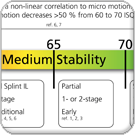|
|

Why Osstell
|
|

How to measure
|
|

Listen to
Osstell users
|
|

Clinical guidance
|
| |
| |
|
|
Frequently Asked Questions Why do I sometimes get an “EM noise” warning when I approach the SmartPeg with the ISQ probe? A: In general, Electromagnetic noise, or “EM-noise” should be taken as an indication that the
environment contains an alternating magnetic field of some magnitude. However there could be sudden
bursts of electromagnetic noise from different electronic equipment, which could sometimes coincide
with a measurement. TV-sets are among those devices that create a lot of noise.
If the probe is close to the instrument (a few centimetres), the noise from the instrument itself
will cause the warning. If the warning is only visible when the probe is held close to a SmartPeg, it can be due to: 1. If the implant is really rigid, it makes the signal from the SmartPeg very strong, which
can cause the warning. Try to distance the probe from the SmartPeg a millimetre or two. Clinically
this should happen very seldom, but on a plastic jaw model for instance, it can be necessary to
hold the probe several millimetres from the SmartPeg, due to the lack of dampening soft tissue. 2. If the SmartPeg is not mounted properly, it can cause the warning. If this has happened the
SmartPeg threads are probably damaged, and it has to be exchanged.
Firmware 12 or later together with probe version 2, makes the instrument less sensitive to
electromagnetic noise. For an upgrade contact your local dealer or Osstell directly. Can I re-use the SmartPegs? The SmartPegs are single use, but one SmartPeg can be used for several measurements on
the same occasion. To avoid damage to the implant, the SmartPeg material is quite soft,
which limits the lifetime of the threads. Autoclaving the SmartPeg weakens the magnet,
which makes it unreliable for measurements. Which Osstell products can be autoclaved? The following products may be autoclaved (over-pressurized steam up to 135 deg Celsius):
- Probe (both the Osstell Mentor probe and the Osstell ISQ probe)
- Probe extension cable
- Transducer
- Transducer screwdriver
- SmartPeg Mount
Please note that SmartPegs are disposable and can not be autoclaved! Is the ISQ-value sensitive to how hard the SmartPeg is tightened? The SmartPeg should be tightened with 4-5 Ncm, which means “finger tight”, using the SmartPeg
Mount. It is enough with firm contact between the SmartPeg and the implant. The difference in
ISQ value will then stay within 2 ISQ units. (If the SmartPeg is tightened too loosely, the
ISQ-value will be lower.) If the SmartPeg is over-tightened, there is a risk that the
SmartPeg threads will be damaged.Why should I take two measurements on the same implant? The SmartPeg measures the stability in all directions and singles out the most stable and
the least stable direction. Sometimes, there is no difference between them. To make sure to
measure both values, the probe should be held perpendicular to the jaw line for one measurement,
and in line with the jaw line for the other measurement. The two ISQ’s represent these values.
If the instrument finds them both at the same time, and they differ more than 3 ISQ units,
they are presented on the display together. What ISQ values can be expected in “normal” cases? The average ISQ is approximately 70. The clinical range that can be seen is from 40-45 up to 85-90. Most implants have between 55 ISQ to 80 ISQ Which value should I use the highest or the lowest? Both the highest and the lowest value reflects the stability situation for a particular implant.
The high value is normally in the mesio-distal direction, and the low value normally in the
bucco-lingual direction. Both give good information about how the implant situation is, and
it can be useful to follow the development of both. What value should I have for immediate loading? It is impossible to base the decision about immediate loading only on the ISQ-value.
The literature shows that good primary stability is essential for a successful outcome,
but there are of course also other parameters that have to be considered in such a decision.
See also above about which ISQ values to expect. Many direct loading studies show good results
with immediate loading if the primary stability is good. It seems as the implant stability will
not change considerably from implantation to after osseointegration in many such cases.
|
|

